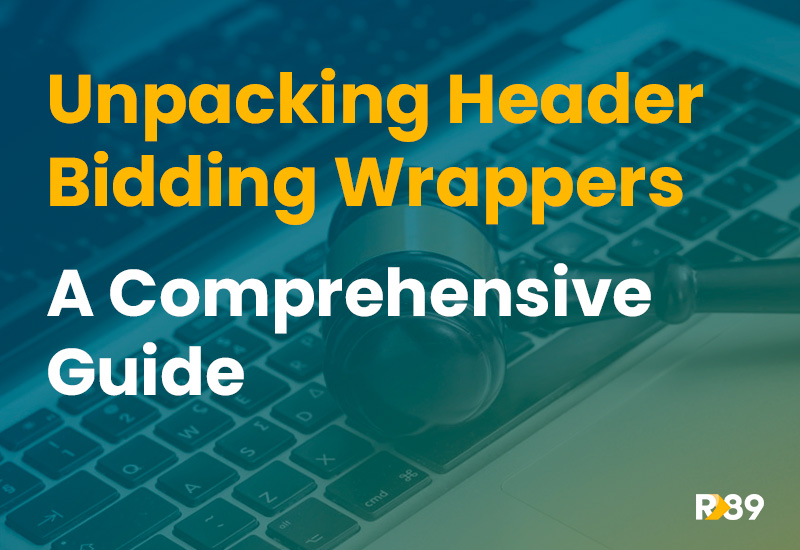Header bidding has revolutionized the way publishers optimize their ad inventory for revenue, but implementing it efficiently can be a complex task. This is where header bidding wrappers come into play. In this guide, we’ll give you some juicy details about header bidding wrappers, exploring what they are, the types available, their benefits, challenges, and how to choose the right one for your needs.
What Is a Header Bidding Wrapper?
A header bidding wrapper is a piece of JavaScript code added to a website’s header. Also known as a container or framework, it serves two primary functions:
1. Running Header Auctions.
It sends requests to demand partners, collects bids from them, and manages the auction process.
2. Defining Rules.
It allows publishers to set rules for efficient auctions. These rules include when the auction starts, the number of participating bidders, auction timeout, floor prices, and more.
Without a header bidding wrapper, managing each demand partner separately can lead to slow page load times, loss of revenue, and increased complexity in consent management.
Types of Header Bidding Wrappers
For publishers looking to implement header bidding, three types of wrappers are available:
1. Open-source Header Bidding Wrappers:
Open-source wrappers are free and adaptable solutions typically maintained by developer communities. Prebid.js is the most popular open-source header bidding wrapper, offering flexibility and pre-built adapters for various ad networks. However, implementing and managing open-source wrappers can be resource-intensive for independent publishers.
2. Proprietary Wrapper Solutions:
Proprietary wrappers are owned by specific SSP platforms and offered as services or licenses for a fee. These solutions often lack transparency and may prioritize the parent company’s exchanges, making them less appealing to publishers seeking independence.
3. Managed Wrapper Solutions
Managed wrappers are ideal for publishers lacking technical resources. They often leverage open-source solutions like Prebid while providing dedicated account managers, implementation support, and ad ops engineers. Managed solutions reduce development complexity and offer transparency, making them suitable for many publishers.
The Role of a Wrapper in Header Bidding
A wrapper acts as a container for adapters, allowing publishers to manage multiple ad partners efficiently. Here’s a brief overview of how it works:
- When a user visits a publisher’s website, the wrapper communicates with multiple ad networks and SSPs through adapters.
- The wrapper sends simultaneous bid requests to all partners.
- Demand partners return bid responses within a specified timeout.
- The wrapper selects the demand partner with the highest bid and passes the bid to the ad server.
- The ad server delivers the winning ad creative to the user.
Benefits of Header Bidding Wrappers
Wrappers offer several advantages:
- Unbiased Auctions: They ensure equal opportunity for all demand partners to bid.
- Easy Demand Management: Wrappers simplify the integration of new demand partners or changes to existing ones.
- Asynchronous Auction: Simultaneous bidding reduces page load times and enhances user experience.
- Universal Timeout: Setting a universal timeout for all partners reduces latency.
- Integrated Analytics: Wrappers provide real-time reporting for performance metrics and yield measurement.
Challenges of Header Bidding Wrappers
Despite their benefits, wrappers pose challenges:
- Implementation and Optimization: Open-source wrappers can be complex to set up and optimize.
- Lack of Technical Expertise: Incorrectly configured wrappers can impact page speed and ad partner performance.
- Limited User Interface Support: Some wrappers may not support certain user interfaces, requiring configuration in the wrapper code.
How to Choose a Header Bidding Wrapper
When selecting a header bidding wrapper, consider the following:
- Demand Partners: Assess the number of demand partners and the ability to add or remove them.
- Support and Analytics: Evaluate the availability of support and analytics.
- Bid Monitoring: Check if the wrapper offers bid monitoring capabilities.
- Discrepancy Resolution: Ensure the wrapper provides tools to handle discrepancies.
- Ad Size Support: Look for support for multiple ad sizes.
- Smart Timeout: Assess the wrapper’s timeout management capabilities.
Best Practices when adding a wrapper
Creating views, make sure the wrapper view:
- Do not overlap other wrappers or the app content.
- Every blank space is a good space for a wrapper (even if you do not plan to use it).
- Do not use only one tag for all of your wrappers, it will be hard to configure your monetization and change it according to your needs.
Why Should Refinery89 be your final partner? Reach us to find out
Outsourcing header bidding wrapper management offers several advantages:
- Fast Start: Outsourcing accelerates setup and saves time and resources.
- Technical Support: It eliminates the need for an in-house tech team, offering support and analytics.
- Lack of Scale: Smaller publishers may struggle to work directly with demand partners, making outsourcing a viable option.
- Wrapper Optimization: Managed service providers help optimize revenue and user experience.
In conclusion, wrappers are essential tools for publishers aiming to maximize ad revenue. Choosing the right type of wrapper and considering outsourcing can streamline the process, allowing publishers to focus on their core business while reaping the benefits of header bidding.








